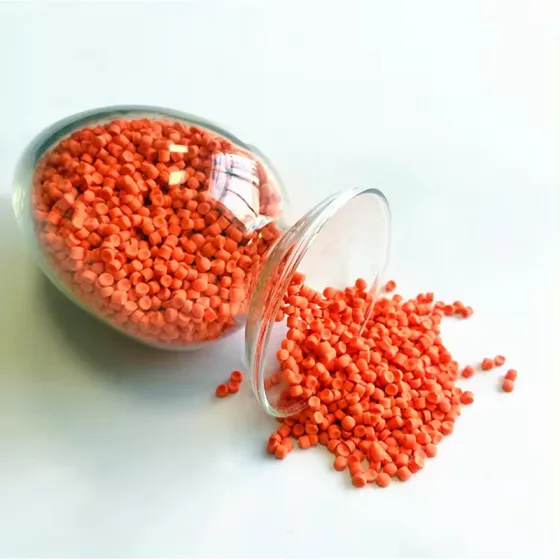

This series of products is made of polymer resin as the base material, and is added with halogen-free flame retardants, cross-linking agents, antioxidants and other additives through mixed plasticization and granulation. It does not contain harmful substances such as heavy metals, has excellent mechanical properties, electrical properties and wide processing temperature margin, meets the requirements of low smoke and halogen-free, and the mechanical properties meet the requirements of XLPE outer sheath wire in the high-temperature electronic wire standard. The flame retardancy can reach UL1581 FT-2 and VW-1 levels. There are series of products with temperature resistance of 105 degrees, 125℃ and 150℃, which meet the environmental requirements of RoHS2.0, Reach, Halogen-free, PAHs, 16P-free, PFOS&PFOA, etc.
This series of products are often used to manufacture high-quality cable materials for high-temperature resistant electronic wires, new energy vehicle cables, charging pile cables, photovoltaic
Features
High Dielectric Strength: XLPE wire has a higher dielectric strength than conventional polyethylene, allowing it to withstand higher voltage levels without breakdown.
Excellent Insulation Resistance: The insulation resistance of XLPE wire is significantly higher than other common insulation materials, such as PVC, making it highly resistant to electrical leakage and short circuits.
Thermal Stability: XLPE wire can operate in a temperature range of -40°C to 125°C, providing consistent performance even in extreme environments.
Chemical Resistance: The cross-linking of polyethylene molecules results in a material that is resistant to a wide range of chemicals, such as oils, greases, acids, and bases.
Mechanical Durability: XLPE wire has high tensile strength, abrasion resistance, and impact resistance, making it suitable for demanding applications.
Flexibility: Despite its toughness, XLPE wire remains flexible, allowing for easy installation and maintenance.
Applications
Power Transmission and Distribution: Due to its high dielectric strength and insulation resistance, XLPE wire is commonly used in medium and high voltage power cables, underground and submarine cables, and overhead lines.
Renewable Energy: In solar and wind energy systems, XLPE wire is used to connect inverters, transformers, and other electrical components.
Automotive: Due to its thermal stability and resistance to liquids and chemicals, XLPE wire is used in automotive wiring harnesses, battery cables, and other high temperature applications.
Industrial: In industrial settings, XLPE wire is used for control cables, instrumentation cables, and communication cables, thanks to its durability and resistance to harsh environments.
Marine and Offshore: XLPE wire's flexibility and resistance to water, chemicals, and extreme temperatures make it suitable for marine and offshore applications, such as onboard power and control systems.
| Test items | UNIT | Test Methods | PFXBK150F | PFXBK150V |
| Density | g/cm^3 | ASTM D792 | 1.35 | 1.42 |
| Tensile strength | Mpa | ASTM D412 | 12.3 | 11.5 |
| Elongation at break | % | ASTM D412 | 310 | 210 |
| Aging conditions | CxH | \ | 180x168 | 180x168 |
| Tensile strength retention | % | ASTM D412 | 108 | 112 |
| Retention of elongation at break | % | ASTM D412 | 85 | 85 |
| Volume resistivity at 20°C | Q.cm | IEC60093 | 4.1x10^16 | 2.2x10^19 |
| Dielectric strength | MV/m | ASTM D624 | 27 | 25 |
| Embrittlement temperature | C | ASTM D746 | ≤-40 | <-40 |
| PH | \ | \ | 5.6 | 5.2 |
| Electrical conductivity | us/mm | ASTM D257 | 1.2 | 1.2 |
| Halic acid gas content | mg/g | \ | 0 | 0 |
| Toxicity index | \ | \ | 1.2 | 1.2 |
| Oxygen index | % | ASTM D2863 | 32 | 36 |
| Smoke density (flamed) | \ | ASTM D2843 | 55 | 50 |
| Flameless | \ | ASTM D2843 | 130 | 125 |
| Flame retardant grade | \ | UL1581 | FT-2 | W-1 |